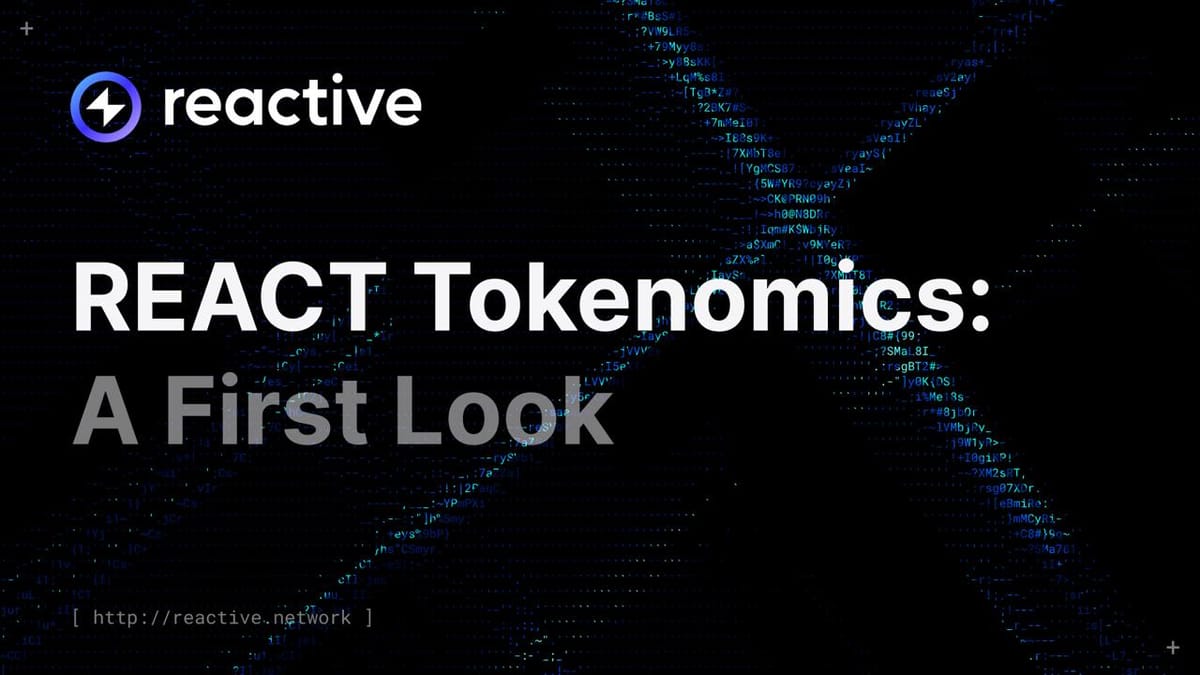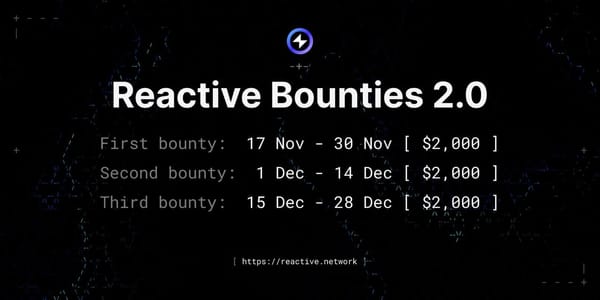$REACT Tokenomics Unveiled: Powering the Future of Reactive Network

We are excited to announce the upcoming launch of the REACT token, the native utility token for the Reactive Network, which will play a central role in our ecosystem. This announcement also includes important details regarding the 1:1 token swap from PRQ to REACT, so be sure to read until the end.
TL;DR:
- We’re launching the REACT token, the native utility token for the Reactive Network, with a 1:1 swap for PRQ tokens.
- REACT will launch with the same total supply as the PRQ token had at launch, with a total supply standing at 500 million tokens at launch, and 310,256,872 in maximum initial circulating supply
- The REACT token will not have any VC allocation and we have returned all VC funding. This is a community-centric token with no supply allocated to private investors. All participants will buy REACT from the public market.
- Our community-centric approach allows us to bring our original vision for Reactive Network to life without compromise, ensuring fairness, with deflationary mechanisms, and real utility for the REACT token.
REACT Tokenomics: A Balanced and Community-Centric Approach
The REACT token will be launched with a total supply of 500 million tokens, identical to the initial supply of PRQ tokens. This ensures that there is no dilution for existing holders, maintaining fairness and trust within our community and preserving our goal of launching Reactive as a true decentralized network.
A maximum of 310,256,872 REACT tokens will be in circulation at launch to support the migration of PRQ to REACT, this is assuming every single holder of PRQ swaps their tokens on day one, the real initial circulating supply is likely to be much lower. This represents over half of the total supply in the hands of the community, instead of institutional investors.
This is the exact amount of PRQ in circulation right now. The remaining 189 million tokens, which were previously burned, will be restored to support the development and incentivization efforts as we launch our full-fledged interoperable blockchain layer.
These restored tokens will be split into different pools for ecosystem building and marketing, some which will be unlocked according to schedule, ensuring a controlled and sustainable release into the market, aligning with the long-term vision of the Reactive Network. The gradual vesting also reinforces our commitment to a sustainable token economy, reducing the risk of sudden market impacts.
Seamless Migration: 1:1 Transition Between PRQ and REACT
We understand the importance of a fair and transparent token migration process. Therefore, we are pleased to confirm that the swap from PRQ to REACT will be on a 1:1 token basis. There will be no lockups for existing PRQ holders, — just a straightforward transition, fair for holders and the community.
Upon the launch of the Reactive Network mainnet, users will have the option to swap their PRQ tokens for either mainnet REACT tokens or bridged ERC20 REACT tokens through our own Reactive bridge, which is expected to go live simultaneously with the mainnet.
Multiple centralized exchanges will also support the migration, providing flexibility and ease of access for our community. The details about CEX migration support will be released soon after the final confirmation.
Utility of the REACT Token
The REACT token is designed to be the backbone of the Reactive Network, providing real utility in several key areas:
- Event Log Processing Fees: The token will also be utilized by reactive smart contracts for processing fees related to event logs autonomously, a crucial aspect of the Reactive Network's functionality.
- Transaction Gas Fees: REACT will be used to pay for transaction fees within the network, ensuring smooth and efficient operations.
- Staking as Validator: Validators will stake REACT tokens to participate in the network's consensus mechanism, earning rewards for securing the network.
Additionally, transaction and processing fees paid in REACT will be burned, contributing to a deflationary mechanism within the network. New tokens will be minted with each block to incentivize validators, but once the daily burned REACT exceeds the daily minted rewards, the network will become deflationary, similar to Ethereum's model.
A Strategic Shift: Embracing a Stronger Community Bond
As part of our commitment to ensuring the success and integrity of the Reactive Network, we decided against involving early-stage VCs in the project. Despite receiving vast VC investor interest, we decided to return the raised funds This approach eliminates the risk of selling pressure from large token holders. Instead, with over half of the REACT supply circulating in the hands of the community, we are proud to maintain a distribution that is truly community-centric and supportive of long-term growth.
Reactive represents the culmination of all the concepts and innovations PARSIQ has developed over the years and it will stand as the ultimate form of PARSIQ's evolution—a full-fledged, public, decentralized infrastructure. This is the endgame for PARSIQ's vision, with Reactive Network carrying forward its legacy as a transformative force in the blockchain ecosystem.
This approach also aligns with our community-centric vision for the REACT token, ensuring that the project remains fair, transparent, and true to its roots without external pressures from VCs and investors.
What’s Next?
We are on track to launch the Reactive Network mainnet in Q4 2024. As we approach this milestone, we will provide more details on the supported exchanges for the migration, as well as additional updates on the network's progress.
Stay tuned for more updates as we continue to build the ultimate interoperable blockchain layer with the REACT token at its core.
For any questions or concerns regarding the swap or the REACT token, feel free to reach out to our team or join our community discussions on Telegram.
Overview: What is Reactive Network?
The Reactive Network is a cutting-edge, fully EVM-compatible blockchain layer designed to revolutionize how dApps operate across multiple ecosystems. By introducing a novel concept called Reactive Smart Contracts, the Reactive Network allows developers to build dApps that can respond dynamically to events happening on other blockchains, making it a powerful tool for cross-chain interoperability.
Key Features of Reactive Network
- EVM Compatibility: The Reactive Network is fully compatible with the Ethereum Virtual Machine (EVM), allowing developers to use familiar tools like Solidity, Truffle, Hardhat, and others to build and deploy their dApps.
- Reactive Smart Contracts: Unlike traditional smart contracts that execute based on user-initiated transactions, Reactive Smart Contracts are triggered by external events from other blockchain ecosystems. This "Inversion-of-Control" model enables more dynamic and responsive dApps that can interact seamlessly across different chains.
- Relayer Network: The Reactive Network's architecture includes a Relayer Network, which facilitates the monitoring of events on various blockchains and ensures that Reactive Smart Contracts receive and process these events efficiently. This setup enables complex interactions between different blockchain ecosystems.
- ReactVM: To optimize performance, Reactive Smart Contracts are executed within a specialized environment called the ReactVM. This virtual machine is designed for parallel execution, allowing transactions to be processed in a highly efficient manner while maintaining the integrity of the contract’s state.
- Interoperability: The Reactive Network is built for interoperability, with the ability to interact with multiple blockchain networks. This includes subscribing to event logs from different chains and executing transactions based on these events, enabling dApps to function seamlessly across various ecosystems.
How Reactive Network Works
Reactive Smart Contracts on the Reactive Network are designed to listen for specific events occurring on other blockchains. When an event matches the criteria set in the contract, it triggers the execution of predefined logic within the Reactive Network. This could involve making a transaction on another blockchain, updating the state of a dApp, or initiating a complex series of actions across multiple networks.
For example, a Reactive Smart Contract might monitor a Uniswap liquidity pool on Ethereum. When the price of a token crosses a certain threshold, the contract could automatically execute a trade, update a database on a different blockchain, and trigger a notification system—all without any manual intervention.
Use Cases for Reactive
- Cross-Chain DeFi Applications: Developers can create DeFi applications that interact with multiple blockchains, optimizing trades, liquidity pools, and yield farming strategies across different ecosystems.
- Event-Driven Automation: Businesses can use Reactive Smart Contracts to automate processes based on real-time events, such as supply chain updates, market conditions, or IoT sensor data, across various blockchains.
- Multi-Chain NFTs: NFTs on the Reactive Network can interact with and derive value from multiple blockchains, enabling more complex and valuable digital assets.
- Decentralized Oracles: Reactive Smart Contracts can serve as oracles, aggregating data from various blockchains and triggering actions based on that data, all while ensuring security and accuracy.
Upcoming Hackathon: Innovate with the Reactive Network
The upcoming Reactive Network Hackathon is an exciting opportunity for developers to showcase their skills and creativity by building on the Reactive Network. This hackathon starts on September 9th and brings together a diverse group of partners, including IQ Wiki, Frax, Manta Network, Uniblock, Pangolin, Intract, QSTN, Burve Protocol and Axelar, among others.
This event is designed to foster innovation and collaboration across the blockchain ecosystem, providing a platform for developers to explore the full potential of Reactive Smart Contracts and cross-chain interoperability. Participants will have the chance to work with cutting-edge technologies, gain exposure to industry leaders, and compete for exciting prizes.
Stay tuned for more details on the hackathon's start date, registration process, and prize structure. We look forward to seeing what our community will create on the Reactive Network!





